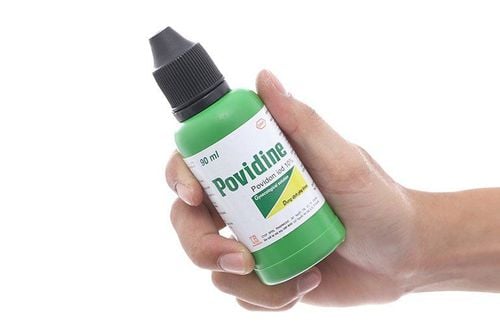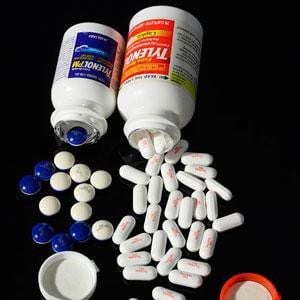Salazopyrine 500mg is used for the treatment of ulcerative colitis. Currently, there is a wealth of information available regarding Salazopyrine 500mg; however, some details remain incomplete. For a more comprehensive understanding of this medication, please read the article below.
1. What is Salazopyrine 500mg?
Salazopyrine is an anti-inflammatory medication that is highly effective in treating arthritis and ulcers in the duodenum or stomach.
Salazopyrine is manufactured by the multinational pharmaceutical company Pfizer (USA). The active ingredients in the medication rapidly address conditions and related complications while providing optimal protection for the gastrointestinal tract, making it an essential treatment option for patients.
Active ingredients and dosage:
- The active substance Sulfasalazine, in a dosage of 500mg per tablet;
- Additionally, the formulation includes water and other excipients in appropriate amounts per tablet.
Dosage form:
- Tablets, packaged in bottles, with each bottle containing 100 tablets.
Pharmacodynamics of Salazopyrine 500mg
- Sulfasalazine is a compound consisting of sulfapyridine and 5-aminosalicylic acid (5-ASA). It is considered a prodrug, as its diazo bond is cleaved by gut microbiota after oral administration, releasing sulfapyridine and mesalamine (5-aminosalicylic acid), which exert antibacterial and anti-inflammatory effects at the site of action.
- The therapeutic efficacy of sulfasalazine in the intestine is attributed to its metabolic derivatives formed in the colon. Adverse drug reactions (ADRs) of sulfasalazine include those caused by both sulfapyridine and mesalamine.
- Additionally, the drug's effects may stem from changes in gut microbiota, reducing Clostridium and E. coli populations in the stool, inhibiting prostaglandin synthesis, which contributes to diarrhea, and altering mucosal transport, affecting the secretion and absorption of fluids and electrolytes in the colon and/or exerting immunosuppressive effects.
- Sulfasalazine also helps reduce inflammatory activity in rheumatoid arthritis, although its exact mechanism and the role of its metabolites remain unclear. It is commonly used alone or in combination with corticosteroids to treat ulcerative colitis and active Crohn’s disease, particularly in the colon.
- Additionally, sulfasalazine is classified as a disease-modifying antirheumatic drug (DMARD) for the treatment of severe or progressive rheumatoid arthritis. However, it is not recommended for juvenile rheumatoid arthritis due to the potential for severe ADRs.
Pharmacokinetics of Salazopyrine 500mg
- Absorption: After oral administration, approximately 10-15% of the sulfasalazine dose is absorbed in its unchanged form from the small intestine. A small fraction of sulfasalazine is absorbed and excreted into bile, undergoing enterohepatic circulation. The remaining portion of the administered sulfasalazine dose reaches the colon intact, where its diazo bond is cleaved by colonic microbiota, producing sulfapyridine and mesalamine (5-aminosalicylic acid, 5-ASA).
- Sulfapyridine is rapidly absorbed in the colon, whereas only a small amount of mesalamine is absorbed from the colon.
- After a single 2g dose of sulfasalazine in healthy individuals, the peak plasma concentration of sulfasalazine reaches 14 µg/mL within 1.5 to 6 hours.
- The peak plasma concentration of sulfapyridine reaches 21 µg/mL within 6 to 24 hours.
- After a single 2g dose of slow-release sulfasalazine, the peak plasma concentration of sulfasalazine is 6 µg/mL within 3 to 12 hours, and that of sulfapyridine is 13 µg/mL within 12 to 24 hours.
- Distribution: Sulfasalazine is highly bound to plasma proteins and is eventually excreted unchanged in urine. The drug crosses the placenta and is detected in breast milk.
- Metabolism: Sulfapyridine undergoes N4-acetylation and hydroxylation in the liver, followed by conjugation with glucuronic acid.
- Excretion: The half-life of sulfasalazine is 5.7 hours after a single dose and 7.6 hours after multiple doses. The half-life of sulfapyridine is 8.4 hours after a single dose and 10.4 hours after multiple doses. Approximately 60-80% of sulfapyridine is absorbed and extensively metabolized in the liver. Mesalamine is minimally absorbed, with about one-third being metabolized and excreted in the urine.
2. Uses of Salazopyrine 500mg
2.1. Anti-inflammatory effects
Sulfasalazine inhibits the production of superoxide radicals by neutrophils upon stimulation by immune complexes or formyl peptides. Additionally, 5-ASA (mesalamine) acts as a strong scavenger of free radicals. Sulfasalazine also inhibits neutrophil function, including chemotaxis and random movement.
Sulfasalazine weakly inhibits cyclooxygenase (COX) but strongly inhibits 15-prostaglandin dehydrogenase (PGDH), the key enzyme in prostaglandin metabolism.
Sulfasalazine has been shown to inhibit several enzymes involved in the arachidonic acid metabolism pathway via lipoxygenase, including 5-lipoxygenase (5-LO) and leukotriene C4 synthetase (LTC4). Additionally, sulfasalazine has been demonstrated to suppress the release of lipoxygenase-derived products by inflammatory cells and tissues.
Moreover, sulfasalazine inhibits enzymes involved in arachidonic acid metabolism, including 5-lipoxygenase (5-LO) and leukotriene C4 synthetase (LTC4). These inhibitory effects contribute to reduced inflammatory responses, likely affecting the clinical efficacy of the drug.
2.2. Effects on immune function
Due to its role in treating autoimmune diseases, the impact of sulfasalazine on immune cells is of interest. In vitro, sulfasalazine inhibits both natural killer (NK) cell activity and T-cell proliferation.
2.3. Antimicrobial effects
Sulfasalazine and its major metabolites inhibit the overgrowth of gut bacteria and reduce the proliferation of certain bacterial species in the gut microbiota.
Salazopyrine 500mg is also indicated as an adjunct therapy for severe ulcerative colitis, appendicitis, distal ulcerative colitis, and Crohn’s disease. It is particularly useful for long-term treatment.
Additionally, Salazopyrine 500mg is prescribed for active rheumatoid arthritis when first-line treatments are ineffective.
3. Side Effects of Salazopyrine 500mg
Common side effects:
- General: Fever, loss of appetite, headache;
- Hematologic: Leukopenia, hemolytic anemia, macrocytosis;
- Gastrointestinal: Nausea, vomiting, epigastric pain, abdominal pain;
- Skin: Rash, urticaria, pruritus, erythema;
- Liver: Transient elevation of transaminases;
- Others: Reversible sperm count reduction.
- Less Common Side Effects:
- General: Fatigue;
- Hematologic: Agranulocytosis;
- Nervous System: Depression;
- Auditory System: Tinnitus.
Rare Side Effects:
- Immune System: Angioedema and serum sickness;
- Hematologic: Pancytopenia, agranulocytosis, thrombocytopenia, and megaloblastic anemia;
- Gastrointestinal System: Pancreatitis;
- Skin: Systemic lupus erythematosus (SLE), Lyell’s syndrome (toxic epidermal necrolysis), Stevens-Johnson syndrome, exfoliative dermatitis, and increased photosensitivity;
- Liver: Hepatitis;
- Respiratory System: Pneumonitis with fibrosis, cough, and respiratory distress;
- Musculoskeletal System: Joint pain;
- Nervous System: Aseptic meningitis and peripheral neuropathy;
- Urinary System: Proteinuria, hematuria, urinary crystals, and nephrotic syndrome;
- Other Reactions: Olfactory dysfunction and taste disturbances.
4. Drug Interactions
Salazopyrine 500mg may interact with the following substances: Azathioprine, Benzocaine, Benzydamine, Celecoxib, Cyclosporine, Dapsone, Folic Acid, Heparin, Hexylresorcinol, Lidocaine, Low Molecular Weight Heparin, Photosensitizing Drugs, Mercaptopurine, Methotrexate, Nitric Oxide, Non-Steroidal Anti-Inflammatory Drugs (NSAIDs), Olsalazine, Prilocaine, Regorafenib, Other Salicylates, Sulfinpyrazone, Tedizolid, Teriflunomide, Tetracaine, Tolvaptan, and the Varicella Virus Vaccine.
5. How to Use Salazopyrine 500mg Effectively
5.1. Administration of Salazopyrine 500mg
Take the tablet whole with plenty of water.
Do not crush, break, or dissolve the tablet in water.
The medication can be taken before or after meals.
5.2. Recommended Dosage
For the treatment of gastric and colonic ulcers, the dosage is as follows:
- Elderly Patients: No specific restrictions on use have been reported.
Adults:
- Initial dose: 1-2g per day (equivalent to 2-4 tablets/day), divided into 3-4 doses taken 6-8 hours apart.
- If using the slow-release form, the dose can range from 0.5-1g per day.
- Once the condition improves, the dose can be reduced to 2 tablets per day.
- Long-term maintenance therapy is recommended to prevent relapse.
Children:
- Dosage is determined based on age and body weight.
- Acute phase: 40-60 mg/kg/day.
- Maintenance dose (to prevent relapse): 20-30 mg/kg/day.
- The dosage of Salazopyrine should be adjusted based on disease severity and individual drug tolerance
5.3. Overdose and Management
Strictly follow the prescribed dosage and administration instructions from your doctor.
If any abnormal symptoms occur, seek medical attention immediately at the nearest healthcare facility.
6. Precautions and Storage
Warnings and Precautions:
- Read the instructions carefully before taking this medication.
- Use with caution in patients with impaired liver or kidney function.
- Do not use expired medication or tablets showing signs of damage, mold, or spoilage.
Use in Pregnant and Breastfeeding Women:
- Careful consideration is required before using this medication during pregnancy or breastfeeding.
Use in Drivers and Machine Operators:
- Use with caution in individuals who drive vehicles or operate heavy machinery, particularly those with impaired liver or kidney function.
- Storage Instructions:
- Store the medication in a cool, dry place with appropriate humidity, at a temperature below 30°C.
- Keep away from moist areas, children, pets, and direct sunlight for prolonged periods.
- Salazopyrine is an effective anti-inflammatory medication for treating arthritis and ulcers in the duodenum and stomach. To ensure safety and maximize therapeutic effectiveness, patients should strictly follow their doctor's prescription when using this medication.
For more useful information on child and family care, visit Vinmec.com
To arrange an appointment, please call HOTLINE or make your reservation directly HERE. You may also download the MyVinmec app to schedule appointments faster and manage your reservations more conveniently.








